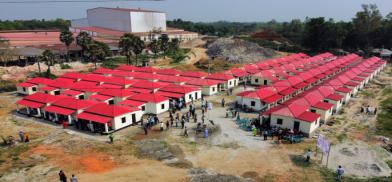Bangladesh's shelter project for the homeless is a model of socioeconomic transformation
The project, like several other initiatives of Bangladesh PM Hasina, has caught the attention of the world's policymakers as the largest such rehabilitation project in the world.

Bangladesh's Ashrayan Project (shelter project for the homeless) is empowering marginalized people through inclusive development, as this housing project plays a vital role in alleviating poverty to help the country attain at least eight targets of the Sustainable Development Goals (SDGs).
The Ashrayan Project is now being used aptly as the Sheikh Hasina Model for Inclusive Development, which has ushered in a new era of growth toward building a Bangladesh free from poverty and hunger. Through the project, Prime Minister Sheikh Hasina has initiated a new dimension of growth and socio-economic development for the homeless populace based on the philosophy - ‘No one will be left behind.’
Over 22,000 landless and homeless families are going to get new houses as a gift from PM Sheikh Hasina. These colourful red, blue and green-roofed houses are being provided in the second phase of the fourth phase of the Prime Minister's Office Asharyan-II project. She hands over these semi-furnished houses along with two hundred acres of land to the families for free on Wednesday. At the same time, the Prime Minister will declare 123 upazilas (a sub-unit of an administrative district in Bangladesh) of the country as completely landless and homeless-free. Of this, all the upazilas of 12 districts have already achieved this development milestone.
A unique rehabilitation project
In May 2020, Ashrayan-2 project under the Prime Minister's Office was taken up, In January 2021, the Prime Minister handed over 63, 999 houses of the first phase of this project. At the same time, 3715 families were rehabilitated in 743 barracks. In June of the same year, the Prime Minister handed over 53,330 houses in the second phase. The number of houses constructed in the third phase was 65,674. And 39,365 houses of the fourth phase were handed over in March this year. The remaining houses of this phase will be handed over soon.
Under this project, 238,851 families have been given houses with land in four stages. A total of 1,194,035 displaced people have been resettled with an average of five members in each family. It is potentially the largest government rehabilitation program in the world in terms of number of beneficiaries and rehabilitation.
Ashrayan is a unique project not only for Bangladesh but also for the world. In different countries, there are various initiatives to help economically backward people in different ways, but there is little precedent for giving ownership of government land to homeless people who have no address and building houses with electricity and sanitation facilities at government expense. In this project, homeless and landless families are provided ownership of two-room semi-paved single-family houses with electricity facilities in the joint name of husband and wife with a 2 percent 'khas' (government-owned land) land settlement. Notably, the project is not only an opportunity for a man and his family to live with dignity, but also a unique example of women's empowerment by ensuring ownership of land to both husband and wife jointly.
How big and comprehensive this campaign is can be understood in some statistics. Studies have confirmed that 555,617 families have been given shelter in the shelter project started in 1997. Apart from shelters, almost similar projects are Veer Nibas, Minority Resettlement, Cluster Villages, Disaster Resilient Houses, and Housing Fund Houses. Together with all these projects, 414,800 landless people in Bangladesh have become house owners along with land owners. More than 28,000 acres of land have been allotted for homestead alone. The visible result is that 334 upazilas, including all upazilas of 21 districts of the country, are landless and homeless-free today. So far, around a million families have received such houses across the country, giving shelter to more than 3.5 million people.
Massive change in socio-economics
In the construction style of the Ashrayan project, one sees in general two-room semi-furnished single houses with a toilet, kitchen and a balcony for each family; specially designed houses for riverside areas; specially designed houses for small ethnic groups in hilly areas; specially designed houses for small ethnic groups in other areas. Multi-storied apartments for climate refugees, paved barracks for coastal people, semi-paved barracks for plain areas, barracks for 'charanchelors' (island areas), and single-room homes for street people. This variety of house construction proves that this initiative is not just a cheap initiative, it has been implemented with very careful thought so that the beneficiary community actually gets the maximum practical benefit in their respective areas.
A house or a family on a piece of land is not only a housing facility, but the shelter has also ushered in massive changes in the socio-economics of the country. Shelters and similar initiatives have empowered the backward communities as well as established them at unique heights of social status by empowering destitute women in land ownership, helping them to return to the mainstream. By eradicating hunger and poverty, providing permanent housing, education, health, and sanitation, ensuring social equity, and rehabilitating climate refugees, this initiative has brought a massive and visible change in the country's rural economy.
The goals of this model are increasing the earning power of the poorest people; establishing their livelihood and social status; empowering women with land and house ownership; increasing self-confidence and self-esteem among women; ensuring environmental protection; and bringing city faciilies to villages.
A careful analysis of the Ashrayan model has found that the beneficiaries of the project have increased their sense of security by 98.87 percent; their social status has increased by 98.5 percent; the standard of living has increased by 95.2 percent; ability to buy new furniture increased 70.22 percent; positive behavior improved 60.78 percent; social harmony increased 60.21 percent; ability to buy electronic devices increased 56.78 percent; savings rate increased by 44 percent; and cultural activities increased by 35.5 percent.
The project, like several other initiatives of Bangladesh PM Hasina, has caught the attention of the world's policymakers as the largest such rehabilitation project in the world. The project is being discussed in the United Nations Human Settlements Program known as UN-Habitat. In the 77th session of the United Nations, held on September 21, 2022, policymakers from various countries including the United Nations participated in the discussion titled 'Refuge: Sheikh Hasina Model for Inclusive Development'.
Today, people around the world can come and see how the poor and neglected women of Bangladesh have also become landowners, and have built their very own homes with their husbands and families. This project has given them respect, dignity, strength, and confidence.
(The author is a Norwegian academic of South Asian studies. Views are personal. He can be contacted at dratlepearsonatle@gmail.com)
Do you have any? Please let me recognize in order that I may just subscribe.
Thanks.
It kind of feels that you are doing any distinctive trick.
In addition, The contents are masterwork. you've performed a wonderful activity on this matter!
Feel free to surf to my page; <a href="https://t.co/eG2x4nxWne">nordvpn coupons inspiresensation</a>
my web site - nordvpn coupons inspiresensation; t.co - https://t.co/vNNQZ7uWLc ,
so I decided to check out your site on my iphone during lunch break.
I really like the info you provide here and can't wait to take a look when I get home.
I'm amazed at how fast your blog loaded on my mobile ..
I'm not even using WIFI, just 3G .. Anyways, very good blog!
Stop by my homepage; <a href="https://t.co/eG2x4nxWne">nordvpn coupons inspiresensation</a>
only go to see this site every day for the reason that it presents feature contents, thanks
Look at my web page :: nordvpn coupons inspiresensation - http://t.co/cFbWYj3h3m
reader. What might you suggest about your publish
that you just made a few days ago? Any positive?
Feel free to surf to my web page - <a href="http://t.co/y7mrgpy3QB">nordvpn coupons inspiresensation</a>
I've learn this put up and if I may I want to counsel
you few fascinating issues or advice. Maybe you could write next articles relating to this article.
I wish to read even more issues approximately it!
My web page :: <a href="https://tinyurl.com/287xqkjf">nordvpn coupons inspiresensation</a>
I used to be suggested this web site by way of my cousin. I'm no longer sure whether
or not this post is written by him as nobody else know such
distinct about my problem. You're wonderful!
Thanks!
my web site :: <a href="http://tinyurl.com/24rpuzvo">nord vpn promo</a>
For newest information you have to pay a quick visit web and
on web I found this web site as a best site for newest updates.
website came up, it appears to be like great. I've bookmarked it in my google bookmarks.
Hi there, simply changed into alert to your weblog thru Google, and located that it's truly informative.
I am gonna watch out for brussels. I'll be grateful if you happen to continue this
in future. Many people can be benefited out of your writing.
Cheers!
Here is my web blog; vpn - http://tinyurl.com/24rrdmtl
find It truly useful & it helped me out a lot. I hope to give something back and help others such
as you helped me.
Feel free to surf to my website nordvpn coupons inspiresensation - http://tinyurl.com/2yzhzyy7
for my knowledge. thanks admin
Here is my site :: <a href="http://tinyurl.com/2yzhzyy7">nordvpn coupons inspiresensation</a>
Here is my homepage: nordvpn coupons inspiresensation - http://t.co/ - http://t.co/vNNQZ7uWLc -
familiarity here with mates.
Here is my blog <a href="https://t.co/eG2x4nxWne">nordvpn coupons inspiresensation</a>
am getting that type of info written in such an ideal
way? I have a challenge that I'm just now working on, and I have been on the glance out for such info.
my web-site :: nordvpn coupons inspiresensation (<a href="https://tinyurl.com/24yrpcga">https://tinyurl.com/24yrpcga</a>)
to be on the web the simplest thing to be aware of. I say
to you, I certainly get annoyed while people think about worries that they plainly don't know about.
You managed to hit the nail upon the top and also defined out the
whole thing without having side-effects
, people could take a signal. Will probably be back to get more.
Thanks
Take a look at my blog post - nordvpn coupons inspiresensation ( tinyurl.com - http://tinyurl.com/2cc6rsmk )
of my know-how. thanks admin
Here is my blog nordvpn coupons inspiresensation - http://t.co/gz5Gi0YSYB
Hello, this weekend is pleasant in support of me,
for the reason that this moment i am reading this great educational post here at my residence.
Visit my blog - nordvpn coupons inspiresensation,
<a href="https://t.co/eVysfVwFqe">https://t.co/eVysfVwFqe</a>,
the web page, that's what this website is providing.
What is vpn connection https://tinyurl.com/2atd6fak
actually impressed to read everthing at one place.
The clearness in your post is just great and i can assume you're
an expert on this subject. Well with your permission let me to grab your feed
to keep updated with forthcoming post. Thanks a million and please keep
up the enjoyable work.
who to ask. eharmony special coupon code 2025 https://tinyurl.com/yneylc4d
your blog. You have some really good articles and I feel I would be a good asset.
If you ever want to take some of the load off, I'd really
like to write some articles for your blog
in exchange for a link back to mine. Please send me an email
if interested. Thanks!










Post a Comment